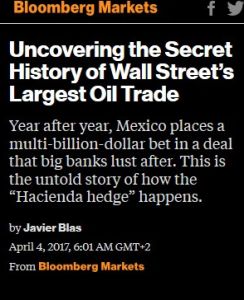Join getAbstract to access the summary!

Join getAbstract to access the summary!
Javier Blas
Uncovering the Secret History of Wall Street’s Largest Oil Trade
Bloomberg Business, 2017
What's inside?
Mexico did what other oil-producing countries don’t – and made a lot of money along the way.
Recommendation
If you have never heard of Mexico’s large, annual oil bets, it’s for good reason: Since the early 1990s, the Mexican government has gone out of its way to keep its Wall Street activities under wraps. Javier Blas, chief energy reporter at Bloomberg News, has gone through thousands of pages of government audit reports and other documents in the United States and Mexico, as well as interviewed government officials, traders and bankers, to tell the story of how Mexico has been protecting itself from oil price fluctuations for all these years. getAbstract recommends this piece of first-rate investigative reporting to energy traders, policy makers and Wall Street insiders.
Summary
About the Author
Javier Blas is chief energy correspondent for Bloomberg News in London.



















Comment on this summary